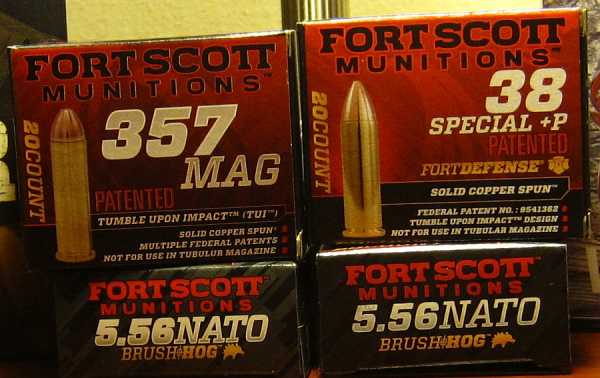
The proprietor of a local firearms emporium asked me if I’d ever used ammunition from Ft. Scott Munitions in gun tests. I admitted I knew nothing of the company and he noted that, being in the same state, it wasn’t smart of me to have never used their product before.
I asked what was so special and he showed a display block of Clear Ballistics gelatin with an impressive turbulence pattern, to say nothing of the penetration. I replied that trick bullets didn’t do much for me.
See, it’s been mentioned to me before that my writing on the subject of defense ammo was the source of some irritation by those companies engaged in the latest, most advanced ammunition technology. I was once asked by one of the designers of super bullets if they should just stop trying.
I replied that trying to advance the art was never wasteful and was worth doing.
Keeping that in mind, FSM uses a very special bullet and tries for a very particular result. I finally checked in with them and asked for a meeting at their shop in Ft. Scott, Ks. It was time to see if it was worth the effort.
I met company president, Robbie Forester, in the showroom at Velocity Tactics, their storefront on Wall Street in Ft. Scott. The secret, it seems, to their bullets is construction: they’re CNC turned copper & brass – the material depending on caliber and applications – and they’re designed to “tumble on impact.”
The first issue to mind was stability in flight and he shook his head. “It remains stable in flight and through non-liquid barriers,” he said. “It tumbles after entering soft tissue, water based media.”

That handles the ‘barrier-blind’ issue some seem to be concerned with these days. The copper projectiles are built for handgun calibers with brass being used in centerfire rifle rounds. Use of solid brass projos for centerfire handguns can be problematic due to prohibitions on “armor piercing” (sic) handgun rounds. Needless to say, the projectiles are lead-free.
They use mostly Starline brass, a reflection of the quality of the company’s manufacturing. They have a rather complete ballistic lab where they can measure pressure and other variables.
Each caliber/cartridge features a unique bullet; the projectile is designed for flight stability with the balance such that they can predict two full “tumbles” within media of the appropriate depth. The “TUI” (tumble upon impact) projectiles are the subjects of a pair of federal patents. The ammunition is sold through non-publicly owned shops, many family-owned – and not through publicly traded corporations.
FSM has been increasingly moving to gain law enforcement agency approvals by going out to do ammunition demos, some of which can be seen in social media. I noted that, even with the tumbling, perforation could be an issue. Company owner Ryan Kraft agreed, but enquired as to hit ratios in law enforcement – and the issue of misses.
“Where do those bullets go?”
He’s right. If you’ve not studied Jim Cirillo’s written record or seen his videos, Stakeout always laid out lanes of fire directing their fire either down, to hit the floor on perforation or on misses, or up above the heads of potential passers-by on the sidewalk in front of the store.
Rule 4 – know your target, what’s behind it, on either side of it and what may pass in front of it – is a life rule, not a range rule.
That said, if a bullet tumbles twice inside a living organism before passing through, exit velocity and the wobbly lack of flight stability would likely create only minimal damage downrange.
How do they know if the rounds work? They shot critters on hunts. Shooting people is generally – and appropriately – frowned upon, so lawfully taken game takes the impact. And they’re not hunting primarily to test ammunition, but because they are hunters.
It’s not just a ‘ballistic jello’ thing and critters aren’t armed criminal offenders. It may be more anecdote than data, but it’s a start. As to pressures and SAAMI, so far one of their rounds is labeled “+P” – the 38 Special, though they’re looking at a standard pressure 38 that will give similar performance. The rest lack the higher pressure designation.

Blue Line Bears photo.
|
Aren’t those CNC machined bullets expensive? Actually, they’re no more costly than bullets that are similarly barrier-blind defense rounds; the cost is about the same. It’s more than range ammo, but it’s about the same as any premium defense round.
Ft. Scott Munitions is also affiliated with Blue Line Bears, a nonprofit organization with the goal of helping the children of fallen law enforcement officers cope with the devastating loss of a parent. The organization, the creation of the 14 year-old daughter of a police officer, reaches out to agencies that lost an officer to get information about the fallen member of service and to get a uniform shirt to transform into a teddy bear keepsake for the officer’s children. Through the use of donations and other contributions, Blue Line Bears purchases all materials, and covers the cost of shipping.
To date, Blue Line Bears has delivered 454 custom hand sewn bears to 36 states and one in Canada.
That association shows the reverence the FSM team has for law enforcement. As to the ammo, there’s no reason it shouldn’t be of the highest quality. The question remains as to its effectiveness on the street. I think that’s more a function of point of impact relative to point of aim – Ryan passed a box of ammunition for me to check that very thing. I know that “only the permanent wound cavity” is “predictive” of performance – right after penetration – and that temporary wound cavity, like that seen with tumbling projectiles, isn’t supposed to be relevant – but . . . I’m back to my own list of standards.
Does it reliably fire? Does it function in the gun? Does it hit to the sights? – And some penetration is good. Otherwise, I’m not terribly concerned. From the information I gathered from various folks who’ve tried Ft. Scott Munitions, their ammo meets two of those standards easily and I had one witness attest to point of impact. So we’ll see.
And we’ll keep you posted.
- - Rich Grassi